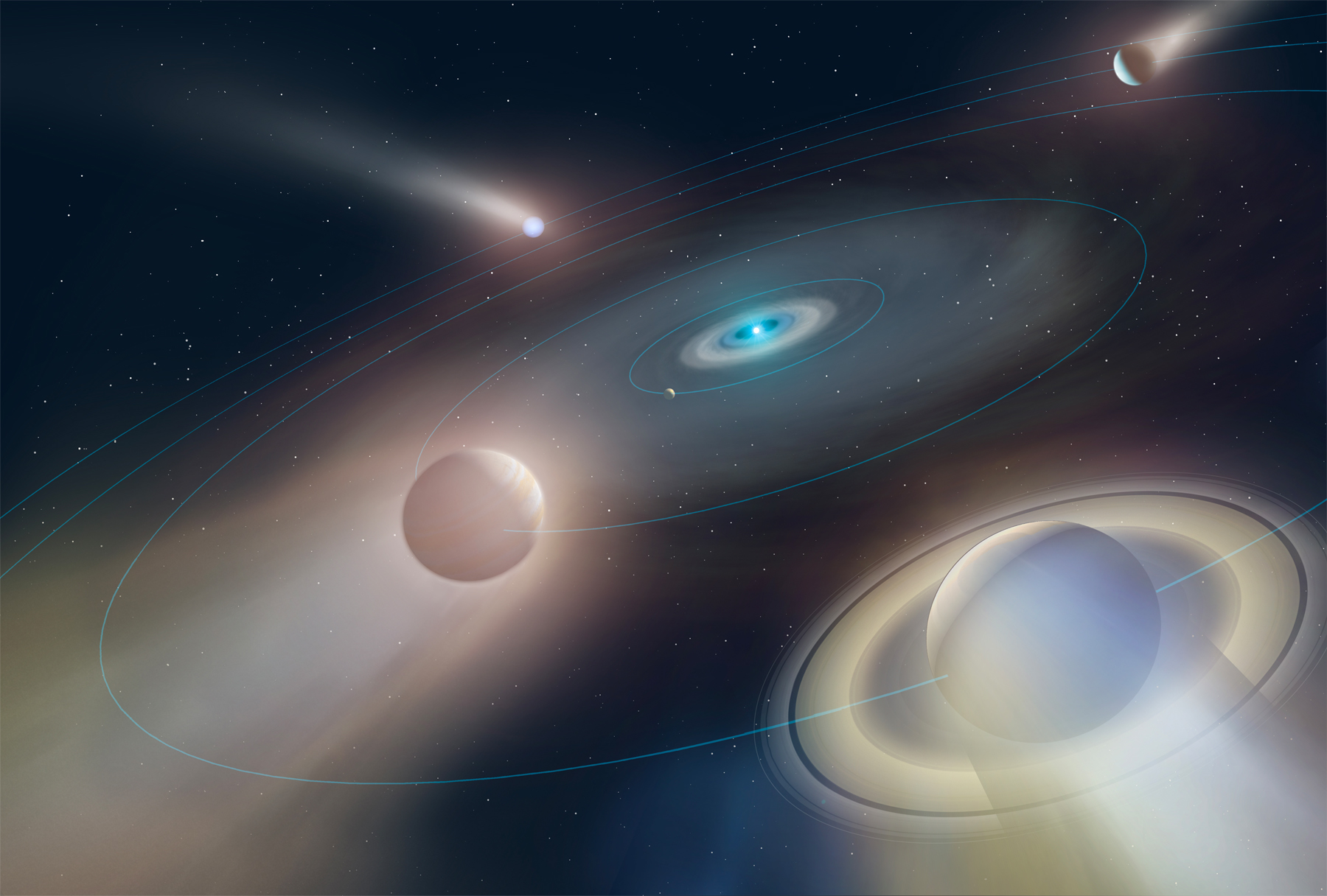Dead stars can have planets, too.
For the first time ever, astronomers have spotted evidence of an exoplanet circling a superdense stellar corpse known as a white dwarf, a new study reports.
"This discovery is major progress, because over the past two decades, we had growing evidence that planetary systems survive into the white-dwarf stage," study lead author Boris Gaensicke, from the University of Warwick in England, said in a statement.
Video: Neptune-Sized Planet Around White Dwarf Discovery Explained
Related: The Strangest Alien Planets in Pictures
"We've seen a lot of asteroids, comets and other small planetary objects hitting white dwarfs, and explaining these events requires larger, planet-mass bodies further out," Gaensicke added. "Having evidence for an actual planet that itself was scattered in is an important step."

The vast majority of stars in the Milky Way galaxy, including our own sun, will end up as white dwarfs. When these stars finish burning their nuclear fuel, they'll first bloat up as enormous red giants, then eventually collapse down into white dwarfs, which pack about one solar mass into a sphere the size of Earth.
(The main exception is really big stars, those that harbor at least eight times the mass of the sun. These behemoths go supernova when they die, and their remnants generally end up as neutron stars or black holes, objects even denser and more exotic than white dwarfs. Neutron stars are known to host planets, by the way; indeed, the first alien worlds ever discovered orbit a type of fast-spinning neutron star called a pulsar.)
Sign up for the Live Science daily newsletter now
Get the world’s most fascinating discoveries delivered straight to your inbox.
Gaensicke and his colleagues studied a white dwarf called WDJ0914+1914, which lies about 2,040 light-years from Earth. In data gathered by the Sloan Digital Sky Survey, the researchers detected emissions of hydrogen, sulfur and oxygen coming from WDJ0914+1914.
That's an odd combination of gases for a white-dwarf system. So, the team trained the European Southern Observatory's Very Large Telescope (VLT) in Chile on WDJ0914+1914. The VLT observations confirmed the presence of all three elements, and suggested that the emissions are coming from a ring of gas around the white dwarf.
"At first, we thought that this was a binary star with an accretion disk formed from mass flowing between the two stars," Gaensicke said. "However, our observations show that it is a single white dwarf with a disk around it roughly 10 times the size of our sun, made solely of hydrogen, oxygen and sulphur. Such a system has never been seen before, and it was immediately clear to me that this was a unique star."
The composition of this disk is similar to that of our solar system's ice giants, Neptune and Uranus, the researchers said. So, it seems that a Neptune-like world — one about four times wider than WDJ0914+1914 itself — is circling the white dwarf once every 10 Earth days.
Related: Our Solar System: A Photo Tour of the Planets

But this planet's days appear to be numbered. Calculations performed by the team indicate that the white dwarf, which has a surface temperature around 50,400 degrees Fahrenheit (28,000 degrees Celsius), is evaporating the alien Neptune at a prodigious rate — about 3,640 tons (3,300 metric tons) per second.
"This star has a planet that we can't see directly, but because the star is so hot it is evaporating the planet, and we detect the atmosphere it is losing," Gaensicke said.
"There could be many cooler white dwarfs that have planets but [lack] the high-energy photons necessary to drive evaporation, so we wouldn't be able to find them with the same method," he added. "However, some of those planets might [be] detectable using the transit method once the Large Synoptic Survey Telescope goes on sky."
The Large Synoptic Survey Telescope is a big observatory under construction in the Chilean Andes; it's scheduled to come online in the early 2020s. (The transit method is a common way to discover alien planets, one made famous by NASA's prolific Kepler space telescope. It involves noticing the tiny dips in a star's brightness caused when a planet transits, or crosses, the star's face.)
To be clear: The researchers did not directly observe a planet around WDJ0914+1914. But the available data point strongly toward its existence, team members said.
"We were stunned when we realized that, when observing hot white dwarfs, we are potentially seeing signatures from extrasolar planet atmospheres," co-author Matthias Schreiber, from the University of Valparaiso in Spain, said in the same statement. "While this hypothesis needs further confirmation, it might indeed open the doors towards understanding extrasolar planet atmospheres."
The new study was published online today (Dec. 4) in the journal Nature. In a companion paper also published today, in the Astrophysical Journal Letters, Schreiber, Gaensicke and colleagues investigate what will happen in our own solar system when the sun exhausts its fuel about 4.5 billion years from now, swelling into a red giant that engulfs Mercury, Venus and likely Earth as well.
The white dwarf that the sun becomes will probably emit enough high-energy photons to evaporate Jupiter, Saturn, Uranus and Neptune eventually, the researchers determined. And some of those planets' constituent gases will likely be detectable by any alien astronomers who may be around and observing our system at that time, just as the material stripped away from the apparent Neptune-size planet circling WDJ0914+1914 is observable to us today.
"In a sense, WDJ0914+1914 is providing us with a glimpse into the very distant future of our own solar system," Schreiber said.
- White Dwarfs: Compact Corpses of Stars
- Death of a Sun-Like Star: How It Will Destroy Earth (Infographic)
- How to Tell Star Types Apart (Infographic)
Mike Wall's book about the search for alien life, "Out There" (Grand Central Publishing, 2018; illustrated by Karl Tate), is out now. Follow him on Twitter @michaeldwall. Follow us on Twitter @Spacedotcom or Facebook.












